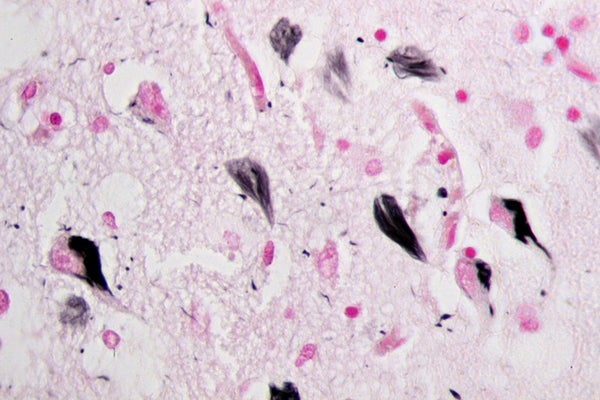A growing body of research has traced the roots of Alzheimer’s disease to the deposition of a protein called tau throughout the brain. To date, however, targeting the rogue protein to treat dementia has produced mixed results, with a promising anti-tau compound recently failing in a late-stage clinical trial. Yet a new study hints that a twist on this established strategy could yield better results. The findings, reported yesterday in Science Translational Medicine, suggest compounds called antisense oligonucleotides, or ASOs, may not only reduce levels of existing tau but also prevent its formation.
ASOs are modified DNA-like molecules designed to recognize and cleave specific RNA sequences thereby preventing them from directing production of a certain protein. The class of drugs is showing promise in treating an array of conditions, including a number of brain disorders: one ASO was approved last year for treating spinal muscular atrophy, a devastating disorder of infancy; others are under investigation for ALS and Huntington’s disease.
The authors of the new study found ASOs prevented cognitive problems in a mouse model of tau brain disorders, or tauopathies, which include not only Alzheimer’s but also rarer brain disorders such as progressive supranuclear palsy and corticobasal ganglionic degeneration. The study also found treatment with ASOs decreased brain inflammation (thought to contribute to Alzheimer’s), prevented neuronal death and even reduced tau aggregates already present in the brain. Advancing a step closer to relevance in humans, the researchers further demonstrated tau-targeted ASO treatment reduces tau protein levels in monkeys. “There are lots of tau-based treatments being looked at,” says lead study author Sarah DeVos, then a graduate student at Washington University School of Medicine in Saint Louis. “But this is the first drug that we’re aware of that actually reduces the expression of the protein–that prevents it from even being made.”
On supporting science journalism
If you're enjoying this article, consider supporting our award-winning journalism by subscribing. By purchasing a subscription you are helping to ensure the future of impactful stories about the discoveries and ideas shaping our world today.
A number of other promising early-stage anti-tau therapies work by harnessing the immune system to attack existing deposits of the protein called “neurofibrillary tangles” due to their entwined nature (think: miniscule cellular tumbleweeds). If the ASO approach can not only help clear such deposits but also prevent them from arising in the first place, it would act as a one–two punch for preventing and treating tau-related disorders. “By preventing new tangles from being made,” DeVos speculates, “we’re lightening the load on the [tau-clearing] cellular machinery.” As a result, the neurons are better able to handle tau that does accumulate.
As with most early-stage treatments, researchers must establish the treatment is safe before they can move forward with human trials. “The toxicology work comes next,” says study senior author Timothy Miller, a neurologist also at Washington University. “We need to make sure antisense oligonucleotides that target tau are safe in humans. Then we need to see if our compound lowers the level of tau in people like it appears to do in mice and monkeys.”
Ultimately, Miller is most enthusiastic about testing whether or not lowering tau is beneficial for people with Alzheimer’s and other tau-based disorders. Alzheimer’s pathology is incredibly complex. Beyond just tau buildup, inflammation of the brain is thought to play a role in the disease, as is accumulation of amyloid protein. One limitation of the new study is its model, which only partially reflects Alzheimer’s; the mice brains used in the research had pure tauopathies with no co-occurring amyloid deposition. Yet as DeVos points out, past work suggests tau deposits are more closely associated with cognitive decline than amyloid.
Another concern that could come with stifling tau production is, given its presence in normal neurons, the protein likely has some vital function. Theoretically, lowering tau could incite some other insult to the brain. Yet no adverse effects of ASO treatment were seen in the new work. DeVos and Miller also say potential side effects could be dealt with because ASOs can be precisely titrated to reduce tau to the desired level.
Experts urged caution in applying these findings to humans. “The results are impressive, though we must remember that mice are not people and extrapolating results from mouse models of human disease to humans needs to be done carefully,” says James Burke, a professor of medicine and psychiatry at Duke University who was not involved with the study. “Therapies that have been successful in amyloid-based mouse models of Alzheimer’s disease have had very limited success in the clinic.”
Burke also points out ASOs cannot be given orally or by intravenous or intramuscular injection. Like the mice in the study, patients would likely require a catheter that delivers medication directly to the brain’s ventricles, the fluid-filled cavities whose contents cushion the brain. Still, he counters, “That would be a small price to pay if there is [a] significant effect of the drug on disease progression.” He also agrees that tau may be a better therapeutic target than amyloid in Alzheimer’s and that DeVos, Miller and their colleagues have moved tau ASOs closer to the neurodegenerative disease clinic.
Richard Isaacson, a neurologist at Weill Cornell Medical College who also not part of the new study, agrees. “While preliminary, this is a promising finding that warrants further study in both animal as well as human trials. The future of Alzheimer’s therapeutics will rely on multimodal approaches that target multiple coexistent pathologies, like amyloid and tau.”
Miller is hopeful. “We think the path to take this forward in humans is clear now, given that these same sort of therapies are showing effectiveness in other neurologic conditions. There’s real potential to move this forward.”
